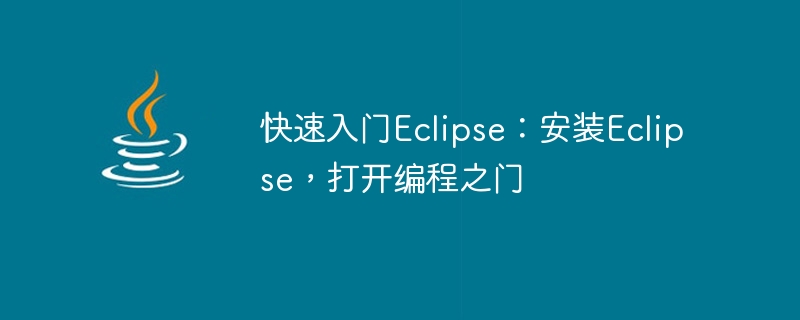Home >Java >javaTutorial >Quick Start Guide for Using Eclipse: Installing and Starting Eclipse for Programming
Quick Start Guide for Using Eclipse: Installing and Starting Eclipse for Programming
- 王林Original
- 2024-01-28 08:11:061420browse

Quick Start Eclipse: Install Eclipse, open the door to programming, you need specific code examples
1. Install Eclipse
Eclipse is a powerful Integrated development environment (IDE), widely used for Java development. Before you start writing code, you first need to install Eclipse. The following are the steps to quickly get started with Eclipse:
1. Visit the Eclipse official website (https://www.eclipse.org/downloads/), click the download button, and select the Eclipse version suitable for your operating system to download.
2. After the download is completed, double-click the installation package to install and follow the displayed instructions to complete the installation.
3. Open Eclipse. When you open it for the first time, you will be prompted to select a workspace. The workspace is where you will save your project files and settings in the future. Select a folder you like as the workspace and click "OK".
4. Now that you have successfully installed and opened Eclipse, you are ready to start writing code.
2. Open the door to programming
In Eclipse, you can use different views and transparency to customize your working environment. The following are some common views and functions:
1. Navigation view (Package Explorer): Displays the project and file structure to facilitate you to browse and manage projects.
2. Edit view (Editor): used to write and edit code. You can open and switch editing views based on different file types.
3. Console view (Console): used to display the output results and error messages when the program is running.
4. Debug view (Debug): used to debug code. You can view the values of variables, set breakpoints, and more while your program is running.
5. Task view (Task): used to record and manage the tasks you marked in the code.
You can find these views in Eclipse's window menu bar. Click Windows->Show View and select the view you want to add.
In addition to views, Eclipse also provides some commonly used functions and shortcut keys.
1. Automatic code completion: When writing code, Eclipse will automatically prompt possible code completion options based on the keywords you enter. Press "Ctrl" and the space bar to trigger code completion.
2. Quick navigation: Press "Ctrl" and the left mouse button in the editor to quickly jump to the defined place or open related files.
3. Quickly fix errors: When there is an error in your code, Eclipse will display the location of the error in the editor and provide options for quick repair. Move your mouse over the error and right-click to select the appropriate repair option.
3. Specific code examples
The following is a simple Java program example that can help you better understand how to use Eclipse to write code:
public class HelloWorld {
public static void main(String[] args) {
System.out.println("Hello, World!");
}
}Copy the above code into the Eclipse editor and save as a Java file (eg HelloWorld.java).
Next, click "Run" -> "Run" or press the "Ctrl" and "F11" keys to run the program. Eclipse will display "Hello, World!" in the console view.
This is a simple example showing how to use Eclipse to write and run Java code. You can create more complex projects in Eclipse and use Eclipse's powerful features and extensions to do more development work.
Conclusion
Through the guidance of this article, you have learned the basic steps to quickly get started with Eclipse and some common views and functions. At the same time, you also learned how to use Eclipse to write and run your first Java program.
If you continue to study Eclipse in depth, you will find its more powerful and flexible functions. I wish you success in your journey of programming with Eclipse!
The above is the detailed content of Quick Start Guide for Using Eclipse: Installing and Starting Eclipse for Programming. For more information, please follow other related articles on the PHP Chinese website!
Related articles
See more- How to Inject Dependencies into Self-Instantiated Objects in Spring?
- Implicit vs. Explicit Waits in Selenium-WebDriver: Which Should You Choose?
- How to Dynamically Add Files to the Java Classpath at Runtime?
- How Can Multi-Catch Blocks Simplify Exception Handling in Java?
- How Can I Handle Value Ranges in Java\'s Switch Statement?

